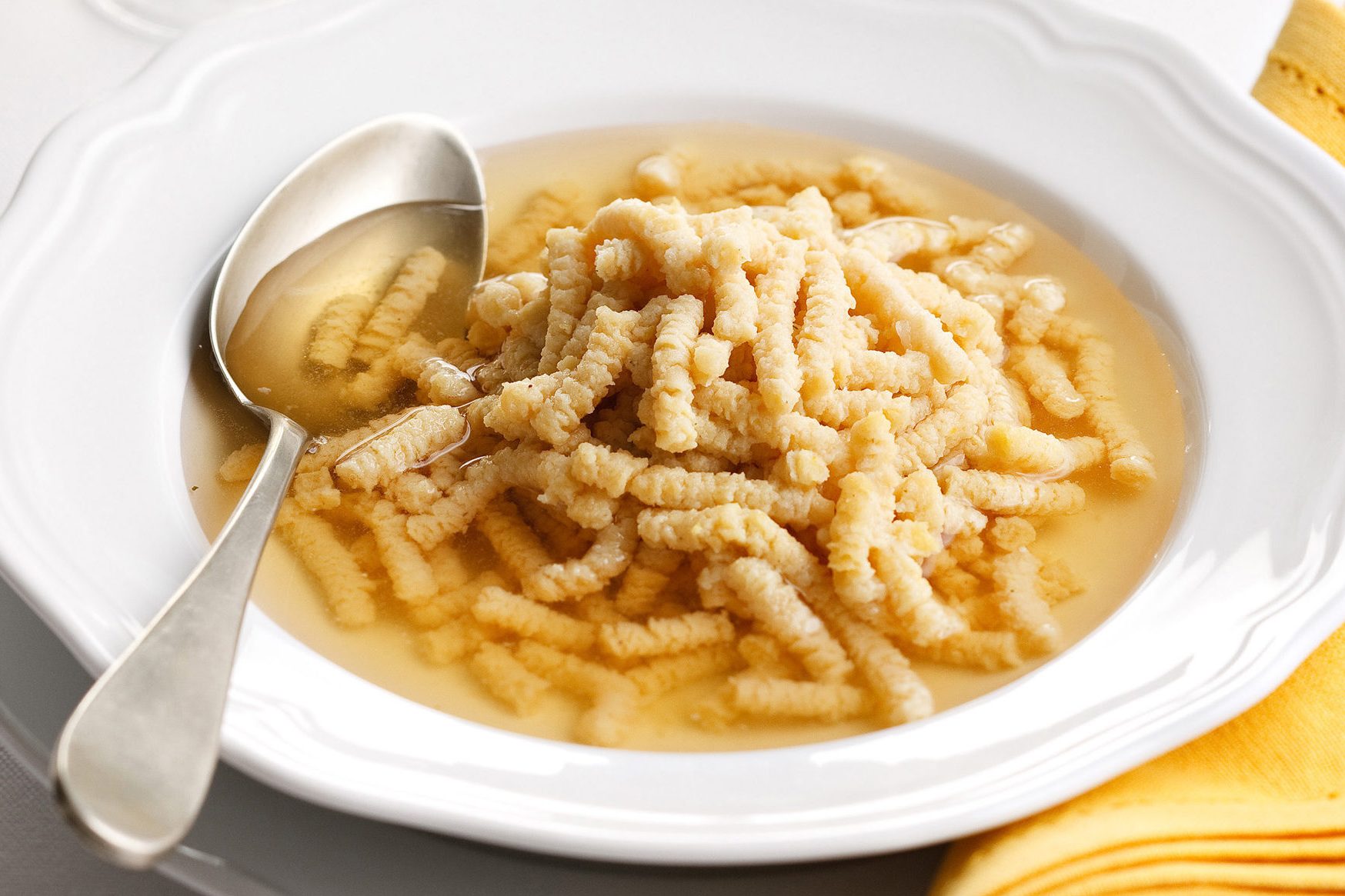Traditionally formed by squeezing breadcrumb-based dough into and out of a multi-holed press like a a potato ricer, passatelli is a noodle that gets its name from how it is made: “passing through.’’
But is it even a noodle?
A specialty of Italy’s Emilia Romagna region, passatelli is technically classified as pasta, but it really shouldn’t be. It’s made using pre-baked bread, not flour, so the gluten-forming process that typically takes place while making pasta does not occur, according to Chef Michele Casadei Massari of Lucciola on the Upper West Side in NYC.
A native of Emilia Romagna, Massari serves passatelli at his restaurant, one of the few places where the easy, cheesy noodles — which are not sold commercially in stores or specialty markets — can be found outside of Italy. Long and thick, the stands of passatelli absorb the liquid from a broth or sauce easily and are known to be very, very filling.
“Passatelli is a take on another recipe that was meant to be a filling meal for a woman after delivering a baby. It’s like a recovery meal. You say, ‘Okay, I’ll give you a great dish of passatelli and you’ll be fine.’ Even after the flu, or after a strong day of work,” Massari tells InsideHook. “Passatelli is great for any form of recovery due to the nutrition coming from the Parmigiano-Reggiano. They are very easy to digest, but at the same time, they make you really feel filled and accomplished in a way. You feel it’s a meal with a heritage and a tradition behind it.”
Massari, who has also spent time working in Japan, likens passatelli noodles to an Italian version of soba because they are so versatile.
“I cannot think of any other noodle that is so equal in both cold and hot,” he says. “The number of ways you can have it at room temperature or even cold. When you are a young kid and you come back late after dancing in Italy in my area, you’re going to have passatelli out of the refrigerator. They’re cold, they’re filling and they are something you’re really used to. They are so versatile. That makes them quite unique. I would say it’s a pasta of a million uses, if we can call it that.”
And it’s a food that Massari is passionate about popularizing, one plate of non-pasta pasta at a time.
“I really, really love them, but they’re not really popular in the United States. But I want to be true to myself with my menu, so I’m going to serve something from my hometown that I eat almost every day,” he says. “Every time we have new customers, they always ask about passatelli. Sometimes we show them a picture and sometimes we even send a plate to share because we really want them to try it. It’s love at the first moment. How can you not love it? There’s umami, it’s filling and there’s cheese, which we all love. The consistency in the bite is really interesting. It’s not too soft, not too hard, not too hot and not too cold. It’s a great sharing plate. You can have a conversation and eat bite by bite. It’s a very charming portion.”
While a trip to visit Massari on the UWS at Lucciola is probably the best way to experience passatelli, here’s his recipe for the version of the dish they offer at the restaurant.
Passatelli with Parmigiano Reggiano Cream and Vinegar
Ingredients (for four people):
- 6 oz heavy cream
- 2 oz grated Parmigiano Reggiano cheese
- Nutmeg
- Black Pepper
- 6 oz bread crumbs
- 7 oz finely grated Parmigiano Reggiano cheese, plus more for serving
- A touch of lemon zest
- A touch salt
- 3 large brown eggs
- Chicken broth (for cooking passatelli)
- Aged Balsamic vinegar (25 years)
Instructions for the Parmigiano Reggiano cream
- To make Parmigiano Reggiano cream, first heat the heavy cream in a saucepan.
- Add 2 oz grated Parmigiano Reggiano cheese 1 tablespoon at a time and stir with a whisk.
- Continue stirring over a low flame until all the cheese is used.
- In the end, the consistency should be similar to a custard. Complete with a pinch of salt and nutmeg.
Instructions for the Passatelli
- Mix dry ingredients in a medium bowl.
- Stir the eggs in with a fork until a dough forms. The dough should be soft, and a little bit sticky, but not too much.
- Add a bit of flour or breadcrumbs if very wet. Cover with plastic wrap and let the dough rest for about 10 minutes or so.
- Bring broth to a gentle boil
- Working with ¼ of the dough at a time, place each portion into a large-holed potato ricer. Press the dough through the potato ricer. To release the passatelli, scrape off the strands with the edge of a sharp knife. Let the strands fall directly into the boiling broth. The passatelli strands will be just over an inch long.
- Cook until the strands float to the top, just a minute or so. Continue with the rest of the dough. With a spider strainer or a large slotted spoon, transfer the passatelli to bowls for serving, keeping them in a warm oven.
- When all the passatelli are cooked, ladle some broth or the Parmigiano Reggiano cream into the passatelli-filled bowls and serve immediately, adding extra grated Parmigiano Reggiano cheese and a drizzle of balsamic vinegar aged 25 years. Serve immediately. The recipe should serve four. Smile!
Join America's Fastest Growing Spirits Newsletter THE SPILL. Unlock all the reviews, recipes and revelry — and get 15% off award-winning La Tierra de Acre Mezcal.
